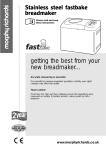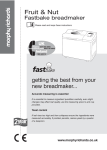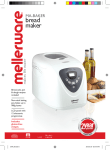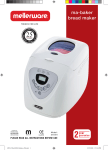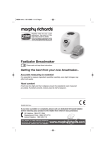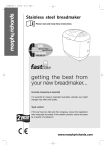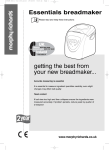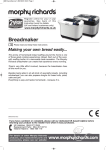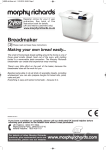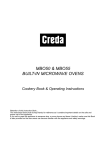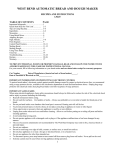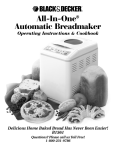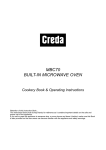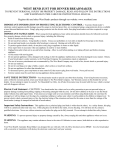Download Morphy Richards IB48880 Operating instructions
Transcript
Breadmaker 48220 series Fastbake 48230 Please read and save these instructions Two year guarantee Exclusions This guarantee is valid in the UK and Ireland only. It is in your interest to retain the retailers receipt as proof of purchase. Please quote the following information if the product develops a fault. These numbers can be found on the base of the product. Morphy Richards shall not be liable to replace or repair the goods under the terms of the Guarantee where: 1 The fault has been caused or is attributable to accidental use, mis-use, negligent use or used contrary to the manufacturers recommendations or where the fault has been caused by power surges or damage caused in transit. 2 The appliance has been used on a voltage supply other than that stamped on the products. 3 Repairs have been attempted by persons other than our service staff (or authorised dealer). 4 Where the appliance has been used for hire purposes or nondomestic use. 5 Morphy Richards are not liable to carry out any type of servicing work, under the guarantee. 6 Plastic filters for all Morphy Richards kettles and coffee makers are not covered by the guarantee. This guarantee does not confer any rights other than those expressly set out above and does not cover any claims for consequential loss or damage. This guarantee is offered as an additional benefit and does not affect your statutory rights as a consumer. Model No. Serial No. All Morphy Richards Products are individually tested before leaving the factory. In the unlikely event of any appliance proving to be faulty within 28 days of purchase it should be returned to the place of purchase for it to be replaced. If the fault develops after 28 days and within 24 months of original purchase, you should contact the helpline number quoting Model number and Serial number on the product, or write to the address below. You will be asked to return the product (in secure, adequate packaging) to the address below along with a copy of proof of purchase. Subject to the exclusions set out below (see ‘Exclusions’) the faulty appliance will then be repaired or replaced and dispatched usually within 7 working days of receipt. If for any reason this item is replaced during the 2 year guarantee period, the guarantee on the new item will be calculated from original purchase date. Therefore it is vital to retain your original till receipt or invoice to indicate the date of initial purchase. To qualify for the 2 year guarantee the appliance must have been used according to the manufacturers instructions. For example kettles should have been regularly descaled or an iron cord should have been stored as recommended by the instructions. The After Sales Division, Morphy Richards Ltd, Mexborough, South Yorkshire, England, S64 8AJ Helpline (office hours): UK (local rate) 08450 777700, Republic of Ireland 1800 409119 IMPORTANT SAFEGUARDS WHEN USING ELECTRICAL APPLIANCES, BASIC SAFETY PRECAUTIONS SHOULD ALWAYS BE FOLLOWED, INCLUDING THE FOLLOWING: 1 Read all instructions carefully. 2 Do not touch hot surfaces. Use oven mitts or oven gloves when removing the hot bread pan. Do not cover the steam vent openings under any circumstances. 3 To protect against electrical shock, do not immerse cord or plug in water or other liquid. 4 Close supervision is necessary when any appliance is used near children. 5 Unplug the power supply cord when the appliance is not in use, or before cleaning. Allow to cool before putting on or taking off any parts, and before cleaning the appliance. 6 If the mains lead of this appliance is damaged do not use it. The lead may only be replaced by Morphy Richards Ltd or an agent of the company, since special purpose tools are required. Telephone Morphy Richards helpline for advice. 7 The use of accessory attachments not recommended by the manufacturer may cause damage to the Breadmaker. 8 Do not use outdoors. 9 Do not let the power supply cord hang over the edge of table or counter, or touch hot surfaces. 10 Do not place the appliance on or near heat sources such as gas or electric stove ovens, or burners. 11 Extreme caution must be given when moving an appliance containing hot contents or liquids. 2 12 To disconnect, press STOP, then switch socket off and remove plug from wall outlet. Grip plug and pull from wall outlet. Never pull on the cord. 13 Do not use the Breadmaker for other than intended use. 14 Avoid contact with moving parts. 15 Put ingredients into the baking pan, then fit the baking pan into the Breadmaker. The baking pan must be in place prior to switching on the appliance. 16 Do not operate this appliance in the presence of explosive and/or flammable fumes. 17 This appliance is intended for household use only and not for commercial or industrial use. 18 To avoid damaging the machine, do not place the baking pan or any object on top of the unit. 19 Do not clean with scouring pads. The baking pan and kneading blade have a non-stick coating. Do not wash the baking pan in a dishwasher. Refer to ‘Cleaning’ section of this book. 20 Do not use Breadmaker for storage purposes nor insert any utensils, as they may create a fire or electric shock. SAVE THESE INSTRUCTIONS Electrical requirements Check that the voltage on the rating plate of your appliance corresponds with your house electricity supply which must be A.C. (Alternating Current). If the socket outlets in your home are not suitable for the plug supplied with this appliance, the plug should be removed and the appropriate one fitted. Note: The plug removed from the mains lead, if severed, must be destroyed as a plug with bared flexible cord is hazardous if engaged into a live socket outlet. WARNING: THIS APPLIANCE MUST BE EARTHED. Should the fuse in the 13 amp plug require changing a 13 amp BS1362 fuse must be fitted. Things you should know about your breadmaker • Your bread maker makes regular 450g (1lb) and large 675g (11/2lb) loaves of bread (approx weights) • There are 11 settings, including one for dough. • A ‘Keep Warm’ function prevents the bread from getting soggy by keeping finished bread warm up to an hour after the baking is completed. This function stops when the unit is turned OFF/STOP or unplugged. • An ‘added-ingredient’ function signals with an audible tone when it is time to add ingredients such as fruits or nuts to recipes used with the Basic Breads (2-3) and Sweet (8) settings. The signal tone comes on 32 minutes into the cycle (after initial kneading) so that your fruit or nuts will remain whole rather than be chopped up by the kneading blade. If you use the TIMER to delay baking, you may add all ingredients at once and bypass this function; however, your fruit or nuts may get somewhat ‘chopped’. • Do not cover the bread maker with towels or other material that may prevent steam from escaping. Some steaming from vents is normal. • Do not place any objects on top of the bread maker. • Unplug the unit and wait until it cools, then remove any food substances from inside the inner case of the Breadmaker by wiping with a damp sponge or cloth. See ‘Care and Cleaning’, page 12 for full cleaning details. • IMPORTANT: Always add ingredients in the order they are specified in the recipe. For best results, accurate measuring of ingredients is very important. The breadmaker and the ingredients should be at room temperature. Do not put larger quantities than recommended into the baking pan as it may produce poor results and may damage the bread maker. Before first use Enjoy using your Morphy Richards Breadmaker. Before first use, please take a few minutes to read this instruction book and to find a place to keep it handy for reference. Pay particular attention to the safety instructions we have provided for your protection. Carefully unpack the Breadmaker and remove all packaging materials. To remove any dust that may have accumulated during packing, wipe the baking pan, kneading blade and outside surface of the Breadmaker with a clean, damp cloth. Do not use scouring pads or any abrasives on any part of the Breadmaker. 3 Components A B Measuring cup and Spoon Kneading blade Wire handle Baking pan Rotating shaft Tablespoon measure C Lid Lid handle Viewing window Vent Baking pan (installed in case) Inner case Control panel Main body Back vents (not visible here) Side vents (on both sides) Power supply cord 4 Teaspoon measure Contents Operating instructions Important Safeguards Things you should know about your breadmaker Before first use Components Control panels settings and functions Setting descriptions How to use your breadmaker Using the timer for delayed completion Slicing and storing bread Care and cleaning Knowing your ingredients Measuring your ingredients Ingredient temperatures Creating your own yeast breads Other tips Special glazes for yeast breads 2 3 3 4 6 7 8-10 10 10 11 12-13 13-14 14 14 14 14 Recipes Yeast breads Basic white bread 100% wholemeal bread Brown bread Soft grain bread Granary bread Italian herb bread Cheese ‘n’ onion bread Pesto bread Olive bread French bread Cottage dill bread Yoghurt bread Sun-dried tomato bread 15 15 15 15 15 15 16 16 16 16 16 16 16 Chunky nut bread Sunny orange bread Raisin bread Mixed fruit bread Peanut butter bread Cranberry nut bread Chocolate bread Dough recipes Russian kulich Bagels Croissants Pizza dough White rolls Wholemeal rolls Raspberry braid Hot cross buns English muffins Raisin kolocky Doughnuts Standard cake mix Banana nut bread Apple and walnut cake 17 17 17 17 17 17 18 18 18 18 19 19 19 19-20 20 20 20-21 21 21 21 21 Jam 22 Fastbake 23 Extrabake 24 Further information Baking cycle times Need help? (questions and answers) Baking tips guide for yeast breads Troubleshooting 25 26-27 28-29 30 5 Control panel settings & functions D 1 1 2 2 3 3 4 4 5 5 NOTE: When using the touchpad controls, be sure to press the pad until you hear a beep. 1 Display window • Shows the setting number you have selected for a particular recipe and shows delayed time, if selected. • Shows minute-by-minute baking time countdown. 2 Timer set Use when setting the TIMER to delay baking. • Shows ▲ and ▼ arrows. • Arrows will move time up or down in 10-minute increments. 3 Select Press to select the setting of your choice, 1 to 11 eg Setting 1 for white Small, 2 for large, 3 for large dark, 4 for small wholemeal, etc. The selected setting automatically assigns the time needed to complete the process. 6 4 Start Press to start operation or begin timer countdown for delayed completion. 5 Stop Press and hold until you hear a beep to stop operation or cancel a timer setting. (Note: Do not press ‘STOP’ when you are just checking the progress of your bread). Setting descriptions NOTE: The number in brackets following each setting description represents the total program time. Basic breads These settings are used for breads which primarily use white flour. These settings have the minimum number of rising cycles and the shortest overall times until baking is completed. Therefore, loaves will be slightly denser than French or Sweet breads. Setting 1 – Small (2 hours 45 minutes) Setting 1 is for smaller loaves and takes less time than Setting 2 and 3. Use this setting if you are adding ingredients such as cheese or nuts as they tend to brown easily. Setting 2 – Large (2 hours 50 minutes) Setting 2 and 3 are for large loaves. Most recipes use Setting 2. Setting 3 - Large Dark (3 hours 10 minutes) Setting 3 has a longer baking time and will produce a loaf with a darker crust. Whole wheat/wholemeal Specialty Setting 7 – French (3 hours 30 minutes) Traditionally French bread has a crispier crust and lighter inside texture than basic breads. Setting 8 - Sweet (3 hours 25 minutes) Use this setting for recipes that use fruit juice, additional sugar, or added sweet ingredients such as coconut flakes, raisins, dried fruit, or chocolate. Baking temperature is reduced to prevent burning and the extra rise cycle gives the loaves a light, airy texture. Setting 9 – Dough (1 hours 30 minutes) This setting makes dough only and will not bake the final bread. Dough can be shaped to make pizza, rolls, doughnuts and round or braided breads that must then be baked in an oven or fried in a deep fryer (ie. doughnuts). Follow dough recipes for specific directions. Setting 10 – Cake (1 hours 50 minutes) Setting 11 – Jam (1 hour) These settings are used for recipes with significant amounts of whole wheat or wholemeal flour. They begin with a delay period of 30 minutes during which the flours or grains soak in the liquid ingredients. Soaking causes the flour or grain to soften and helps ingredients to combine well. These settings also have an extra rise cycle to allow heavy wheat/grains to expand. Breads made with wholewheat/wholemeal flour are lower in volume and have a dense texture, compared to breads made with white flour. Setting 4 - Small (4 hours 20 minutes) Setting 5 - Large (4 hours 30 minutes) Setting 5 has a slightly longer bake time than 4 and loaves will have a darker crust. Use 4 to obtain a lighter crust or for recipes with added ingredients (bran, raisins, dried fruit, fruit juice) which may brown easily. Setting 6 - Large Rapid (3 hours 20 minutes) 7 How to use your breadmaker The 8 bread settings in this unit will combine ingredients, knead and make bread from start to finish automatically. The DOUGH setting makes dough for a variety of recipes but you must shape and bake the dough yourself in an oven. To delay completion, the automatic TIMER may be programmed to make bread or dough while you are at work or asleep. (See ‘Using The Timer For Delayed Completion’ pg. 11). E For all settings (1 to 11) 1 Open the lid and remove the Baking Pan by pulling straight up on the handle. It is important to remove the Baking Pan from the unit rather than putting ingredients into the Pan while it is in place to avoid accidentally spilling ingredients into the inner case. Warning: Place your automatic breadmaker where it is level, stable and secure. 2 Attach the kneading blade onto the shaft inside the baking pan by lining up the flat side of the blade with the flat side on the shaft. Push the blade firmly onto the shaft. • Be sure to set the kneading blade firmly into place otherwise the blade may come off during operation, which may affect the kneading or mixing. • Be sure the shaft is clean of any residue (i.e. dough). This will ensure the kneading blade will fully seat into place. 3 Measure ingredients carefully and accurately. • To measure liquids, use the cup provided and check the measurement at eye level. • When measuring dry ingredients, use the cup provided (ensure it is dried after measuring the liquid) and level the ingredients with a straight edge knife. • Inaccurate measurement, even if only slightly out, can make a difference in results. Use the measuring spoon and level off with a straight edge knife. (See ‘Measuring your ingredients’ pages 14-15). • Always add ingredients into the baking pan in the order they are listed. • Yeast is always added last. Be sure that the yeast does not touch the liquid ingredients. • Be careful not to mix the yeast with any of the wet ingredients especially when using the delayed timer feature, otherwise the bread may not rise properly. 8 F G Liquids H Dry Ingredients (ie. flour) J Yeast 4 Place the baking pan back into the unit. with the word FRONT on the rim of the Pan facing towards the front of the Breadmaker. Push down on the pan until you hear it click firmly into place. Fold the handle down. K Special Note If the baking pan is not installed in the proper orientation or firmly clicked into place the kneading blade will fail to operate. The baking pan can only be installed in one position as indicated. 5 Close the lid and connect the plug to an electrical socket. You will hear a beep sound and the display window will be blank. L 6 Select the appropriate setting for your recipe (1-11 or 0-12 dependent on model) by pressing the SELECT button on the pad. Each time SELECT is pressed, the number in the display window will advance to the next setting. M 7 Press START. The baking time in hours and minutes will appear in the display. For example, if you chose a recipe using setting 1, the display will show 2:45. It will count down the remaining bake time in one-minute decrements (2:44, 2:43, etc) until the bread is done. When the baking time is completed, a signal tone will sound three times and the display window will flash ‘END’. makers surface, do not put any object or the hot baking pan on top of the unit. 8 This Breadmaker is designed with a ‘Keep Warm’ function that automatically begins when the BAKE time is completed. At the end of the BAKE cycle ‘END’ will appear (in the display window) up to 60 minutes after baking is complete and will keep the bread warm during that time. You may remove the baking pan at any time during the ‘Keep Warm’ cycle. To turn off the ‘Keep Warm’ feature before the 60 minutes are up, simply press the STOP button and hold it for 3 seconds until you hear a ‘beep’. END will disappear and the display window will now be blank. • UNPLUG THE UNIT WHEN FINISHED. Never leave the unit plugged in when not in use. The ‘Keep Warm’ feature is not provided for the jam or DOUGH settings 5. If you keep finished dough in the Breadmaker over a period of time, it may overrise and produce poor results. For best results, remove dough at the end of the cycle and follow the recipe directions for shaping, resting and baking. 9 This Breadmaker has a convenient Viewing Window so that you may watch the progress of the bread as it is mixed, kneaded, and baked. Occasionally some moisture may be formed in the window during processing. If moisture forms, you may lift the lid to look inside during the mixing and kneading stages, however do not open the lid during the baking cycle (approximately the last hour or so) as this may cause the bread to collapse. 10 To remove the bread from the baking pan, use an oven glove or oven mitts and pull straight up on the baking pan handle. Turn the pan upside down and shake the bread out onto a wire cooling rack. The baking pan has a non-stick coated finish so that the bread should come out easily. Do not use metal utensils to remove bread as they may scratch the non-stick coating. If you have difficulty removing bread from the baking pan, slide a flat rubber or plastic spatula along the sides of the pan to loosen the loaf. Turn the pan over and shake the loaf out. Allow the bread to cool before slicing (See ‘Slicing and Storing Bread’ page 11). • If the kneading blade remains in the bottom of the baking pan, it may be necessary to fill the baking pan with warm water in order to loosen the kneading blade from the shaft. N O Warning Do not place the baking pan or any other object on the top of the unit. To avoid damaging the bread 9 • If the kneading blade remains in the bottom of the loaf of bread, use the end of a plastic spoon or other non-metal utensil to remove. Always check to see where the kneading blade is when removing a baked loaf of bread. If it remains stuck in the bread you may accidentally damage it by cutting into it while slicing. Using the timer for delayed completion Use the TIMER when you would like to delay the completion of your bread. This feature allows you to delay the bake time for up to 12 hours plus the cycle time. For example, you can set the TIMER in the evening and wake to fresh bread the following morning. NOTE: Be sure you have followed the ‘How to Use Your Breadmaker’ steps 1-6 in preparing the ingredients in the baking pan. It is not recommended that you use the ‘Delayed Completion’ function and TIMER with recipes that call for fresh ingredients which might be spoiled such as eggs, fresh milk, sour cream, or cheese. 1 To set the TIMER, determine when you would like your bread to be finished. • For example, if it is 8pm when you place all your ingredients in the baking pan and you would like to wake up to the aroma of fresh-baked bread at 8am, you will want a total of 12 hours before your bread is complete. Once you have chosen the appropriate setting for your recipe (for example, if you are doing a Sweet bread, you will push SELECT until 8 is showing in the display), you simply set the TIMER to bring it up to your total hours – in this case 12 hours. 2 Press the ▲ arrow on the control panel and 3:25 – the timer for setting 8 – will automatically come up in the display window. Continue to Press ▲ until the display reads 12:00 (or is as close to this as possible, since your timer moves in 10 minute increments, your actual reading for this setting will be 11:55 or 12:25). • You do not need to mathematically calculate the difference between the setting time (3:25) and the total hours you want (12:00). The machine will automatically adjust to include the setting time. Simply set the TIMER for your total hours (12). • If you pass the desired time, simply press ▼ to go back. 10 3 Once you have set the time, press START. The colon (:) in the display will flash to indicate that the TIMER has been set and the countdown will begin. The TIMER will count down in one-minute increments. When the display reaches END, your bread is complete and the beeper will sound. 4 If you make a mistake while setting the TIMER, press and hold the STOP button until it beeps. This will clear the display and you can set the TIMER again. Slicing and storing bread For best results place bread on a wire rack and allow to cool for 15 to 30 minutes before slicing. You may use an electric knife for even slices. Otherwise, use a sharp knife with a serrated blade. Store unused bread tightly covered at room temperature for up to three days. If weather is hot and humid, store in the refrigerator overnight. For longer storage (up to one month), place bread in a tightly covered container in the freezer. If you store the bread in the refrigerator, leave it out to bring it to room temperature before serving. Since homemade bread has no preservatives it tends to dry out and become stale faster than commercially made bread. Leftover slightly hardened bread may be cut into 1.3 cm (half inch) or 2.5cm (1 inch) cubes and used in favourite recipes to make croutons, bread pudding, or stuffing. Care and cleaning Caution To prevent electrical shock, unplug the unit before cleaning. Wait until the breadmaker has cooled prior to cleaning. Do not immerse or splash either the body or lid in any liquid as this may cause damage and/or electric shock. For best performance and maintenance, it is recommended to clean the Breadmaker after each use as follows: Outer body, lid and inner case P Wipe the lid and outer body of the unit with a damp cloth or slightly dampened sponge. Use a damp sponge or cloth to wipe out any flour, crumbs, or other materials from the inner case. Baking pan and kneading blade Both the baking pan and kneading blade have a non-stick coated surface. Do not use any harsh cleansers, abrasive materials or utensils which may scratch their surfaces. Over time, the non-stick surface may change in appearance due to moisture and steam. This is normal and has no effect on its use or quality. Remove the baking pan and kneading blade from the inner case before cleaning. To remove the blade from the baking pan, hold the drive underneath the base of the pan. If required, rotate the blade back and forth a few times and pull to remove. If you still have difficulty removing the blade, fill the baking pan with hot, but not boiling, water and allow to soak for 30 minutes. This should loosen the blade enough for it to be removed. Wipe the outside of the baking pan with a damp cloth. You may hand wash the inside of the baking pan with soapy water. The drive shaft on the inside base of the pan should also be cleaned. The hole in the centre of the kneading blade should be cleaned with a plastic or wooden tooth pick and a drop of cooking oil put in the hole to prevent sticking. Q The kneading blade should be removed and cleaned after each use. If the blade remains in the base of the loaf of bread, carefully remove and clean. Do not use any of these when cleaning your breadmaker: • Paint Thinner • Benzine • Steel Wool Pads • Polishing Powder • Chemical Dustcloth CAUTION: None of the breadmaker parts are dishwasher safe. DO NOT place the baking pan or kneading blade in the dishwasher. Never submerge the baking pan in water. Special care for the non-stick finish. Avoid damaging the coating. Do not use metal utensils such as spatulas, knives or forks. The coating may change colour after long use, this is only caused by moisture and steam and will not affect the performance of the unit or quality of your bread. Storing the unit Be sure to dry all parts before storing including wiping any moisture from the viewing window. Close the lid and do not store anything on top of the lid. The electrical cord The cord length of this appliance has been selected to reduce the possibility of tangling or tripping over a longer cord. If additional cord length is needed, an extension cord rated not less than 13 amperes, 240 volts and BS certified, may be used. If using an extension, be sure to arrange it so that it cannot be pulled or tripped on. Troubleshooting Specific questions about the breadmaker functions and problems with ingredients or recipes are addressed in the ‘Need Help?’ section starting on page 25. 11 Knowing your ingredients Introduction Waking to the smell of homemade bread baking in the kitchen is one of the most comforting memories of childhood. Can you remember rushing downstairs to taste the bread, hot out of the oven, with butter melting on top? What a great way to start the morning. The breadmaker can create that same experience every morning. There's very little effort on the part of the baker, because this automatic breadmaker is a sophisticated counter top appliance with a computer memory that does all the work for you. Just follow the recipe instructions, and wake up to fresh baked bread in your automatic breadmaker. But don't stop at baking bread in this appliance. Besides being able to do all kinds of speciality breads, including wholemeal, you can also prepare doughs for croissants, bagels, doughnuts, pizzas and more. Everything is easy and tastes homemade, because it is. Understanding baking It is often said that cooking is an art relying on the creativity of the chef while baking bread is much more of a science. This means that the process of combining flour, water and yeast results in a chemical reaction that produces bread. You have to remember that when the ingredients combine with each other they produce a specific result. Read the following information carefully to gain a better understanding of the importance each ingredient plays in the breadmaking process. Important special note on flours Flours, while visibly similar, can be very different by virtue of how they were grown, milled, stored, etc. You may find that you will have to experiment with different brands of flour to help you make that perfect loaf. A Baking Tips Guide has been provided on pages 28-29 of this book to assist you with these experiments. Storage is also very important, as all flours should be kept in a secure, airtight container. All purpose flour/plain flour All-Purpose Flour is a blend of refined hard and soft wheat flours especially suitable for making cake breads. This type of flour should be used for recipes in the cake/quick bread section. Strong plain flour/bread flour Bread Flour is a high gluten/protein flour that has been treated with conditioners that give dough a greater tolerance during kneading. Bread Flour typically has a higher gluten concentration than All Purpose Flour; however, depending on different milling practices this may vary. Strong plain flour or 12 bread flour are recommended for use with this Breadmaker. Whole wheat flour/wholemeal flour Whole wheat flour/wholemeal flour is milled from the entire wheat kernel which contains the bran and germ and makes it heavier and richer in nutrients than All purpose flour. Breads made with this flour are usually smaller and heavier than white loaves due to the sharp edges of the bran and the germ cutting the gluten strands. To overcome this whole wheat flour/wholemeal flour is usually mixed with Bread flour or strong plain flour to produce a high light textured bread. Self-raising flour Self Raising Flour contains unnecessary leavening ingredients that will interfere with bread and cake making. It is not recommended for use. Bran Bran (unprocessed) & Wheat Germ are the coarse outer portions of the wheat or rye grains separated from flour by sifting or bolting. They are often added in small quantities to bread for nutritional enrichment, heartiness and flavour. They are also used to enhance the texture of bread. Oatmeal Oatmeal comes from rolled or steel-cut oats. They are used primarily to enhance flavour and texture. Yeasts (active dry yeast) Yeast through a fermentation process produces gas (carbon dioxide) necessary to make the bread rise. Yeast must be able to feed on sugar and flour carbohydrates in order to produce this gas. Active dry granular yeast is used in all recipes that call for yeast. There are basically three different types of yeast available, fresh, dry and instant quick rising. It is recommended that traditional dry yeast be used, however, instant quick rising can also be used in lesser amounts. (Note: The recipes in this cookbook were developed using traditional dry yeast). Fresh or compressed cake yeast is not recommended as they will produce poor results. Store yeast according to manufacturers instructions. Ensure your yeast is fresh by checking its expiration date. Once a package or can of yeast is opened it is important that the remaining contents be immediately resealed and refrigerated as soon as possible for future use. Often bread or dough, which fails to rise, is due to stale yeast being used. The following test can be used to determine whether your yeast is stale and inactive: 1 Place half cup of lukewarm water into a small bowl or cup. 2 Stir 1 tsp. of sugar into the water then sprinkle 2 tsp. of yeast over the surface. 3 Place bowl or cup in a warm area and allow to sit for 10 minutes undisturbed. 4 The mixture should foam and produce a strong yeast aroma. If this does not occur, discard mixture and start again with another packet of dried yeast. Sugar Sugar is important for the colour and flavour of breads. It is also food for the yeast as it supports the fermentation process. Artificial sweeteners cannot be used as a substitute for sugar as the yeast will not react properly with them. Salt Salt is necessary to balance the flavour of breads and cakes, as well as for the crust colour that develops during baking. Salt also limits the growth of yeast so the amounts shown in the recipes should not be increased. For dietary reasons it may even be eliminated entirely, however, your bread may overproof and rise higher than normal. Liquids/milk Liquids such as milk or a combination of powdered milk and water, can be used when making bread. Milk will improve flavour, provide a velvety texture and soften the crust, while water alone will produce a crispier crust. Some liquids call for juice (orange, apple, etc) to be added as a flavour enhancer. Note: For most recipes we suggest the use of dry skimmed milk. Eggs Eggs add richness and a velvety texture to bread doughs and cakes. Butter & margarine Butter and Margarine ‘shortens’ or tenderises the texture of yeast breads. Breads that call for butter stay fresh longer. If butter or margarine is used direct from the refrigerator, it should as softened for easier blending during the kneading cycle. Sunflower oil can be used as a substitute for butter or margarine. Measuring your ingredients The key and most important step when using your Breadmaker is measuring your ingredients precisely and accurately. It is extremely important to measure each liquid and dry ingredient properly or it could result in a poor or unacceptable baking result. The ingredients must also be added into the baking pan in the order in which they are given in each recipe. Liquid and dry measurements are done somewhat differently and are as follows: Liquid Measurements Use the cup provided. When reading amounts, the measuring cup must be placed on a horizontal flat surface and viewed at eye level (not on an angle). The liquid level line must be aligned to the mark of measurement. A ‘guesstimate’ is not good enough as it could throw out the critical balance of the recipe. R Dry Measurements Dry measurements (especially flours) must be done using the measuring cup provided. Dry measuring must be done by gently spooning ingredients into the measuring cup and then once filled, levelling off with a knife. Scooping or tapping a measuring cup will pack the ingredients and you will end up with more than is required. This extra amount could affect the balance of the recipe. Do not sift the flour, unless stated. S T Baking powder Baking powder is a raising agent used in quick breads and cakes. This type of raising agent does not require rising time before baking as the chemical reaction works when liquid ingredients are added. Bicarbonate of soda Bicarbonate of Soda is another raising agent not to be confused or substituted for baking powder. It also does not require rising time before baking as the chemical reaction works during baking process. When measuring small amounts of dry or liquid ingredients (ie yeast, sugar, salt, powdered milk, honey, molasses) the standard measuring spoon which is provided must be used. Measurements must be level, not heaped as this small difference could throw out the critical balance of the recipe. Your breadmaker produces delicious baked goods with ease. This machine asks only that you carefully follow the recipe instructions. In basic cooking, normally ‘a pinch of this and a dash of that’ is fine, but 13 not for breadmakers. Using an automatic breadmaker requires you accurately measure each ingredient (especially yeast and water) for best results. For best results, have your ingredients and breadmaker at room temperature unless otherwise specified. Ingredient temperatures All ingredients, especially liquids (water or milk), should be warmed to room temperature 21°C (70°F). If ingredients are too cold, below 10°C (50°F), they will not activate the yeast. Extremely hot liquids, above 40°C (104°F), may kill the yeast. Creating your own yeast breads With the breadmaker, even the most inexperienced baker can achieve the satisfying experience of baking a loaf of bread. All of the mystery and hard work is gone. Inside this talented machine with a computer brain, the dough is mixed, kneaded, proofed and baked without you being present. The automatic breadmaker can also just prepare the dough, and when it's ready, you shape and bake in a conventional oven. The recipes on the following pages are ‘tailored’ or this breadmaker. Each recipe features ingredients that best compliment a particular loaf of bread, and each was tested in our machines. It is extremely important not to exceed the amounts of flour specified in each of the recipes or else it could result in unsatisfactory baking performance. When creating your own yeast bread recipes or baking an old favourite, use the recipes in this cookbook as a guide for converting portions from your recipe to your breadmaker. Other tips • Place all recipe ingredients into the baking pan so that yeast is not touching any liquid. • After completing the process of making dough in your breadmaker, typically when letting dough rise outside the breadmaker, allow 30 minutes or until dough doubles in size. Dough should be lightly greased and covered with waxed paper and a dry towel. It should be placed in a warm area free from drafts. • Humidity makes dough more moist, therefore humidity and high altitudes require adjustments. For humidity, add an extra tablespoon of flour if consistency isn’t right. For high altitudes, decrease yeast amount approximately 1/4 teaspoon, and decrease sugar and/or water or milk slightly. (See Baking tips guide pages 28-29). • The DOUGH setting is great for mixing, kneading and proofing (allowing dough to rise) richer dough like croissant doughs. Use the automatic 14 • • • • breadmaker to prepare this dough so all you need to do is shape and bake it according to your recipe. When recipes call for a ‘lightly floured surface,’ use about 1 to 2 tablespoons of flour on the surface. You may want to lightly flour your fingers or rolling pin for easy dough manipulation. When you let dough ‘rest’ and ‘rise’ according to a recipe, place it in a warm, draft-free area. If the dough doesn't double in size, it may not produce a tender product. Dough is ready when an indentation remains when it is touched. If the dough you are rolling shrinks back, let it rest covered for a few minutes before rolling again. Dough may be wrapped in plastic and stored in a freezer for later use. Bring the dough to room temperature before using. Special glazes for yeast breads Give your just baked bread a professional finish. Select one of the following special glazes to enhance your bread. Egg Glaze Beat 1 large egg and 1 tablespoon of water together, brush generously (Note: apply only to doughs before baking). Melted Butter Crust Brush melted butter over just baked bread for a softer, tender crust. Milk Glaze For a softer, shiny crust, brush just baked bread with milk or cream. Sweet Icing Glaze Mix 1 cup sifted icing sugar with 1 to 2 tablespoons of milk to make a glaze consistency and drizzle over raisin bread or sweet breads. Poppy/Sesame/Caraway Seed/Oatmeal Sprinkle your choice of these seeds generously over just glazed bread. Recipes Brown bread Small = 450g (1 lb) bread approx Large = 675g (11/2 lb) bread approx Recipe method All of the following recipes use this same general method: 1 Measure ingredients into baking pan. 2 Insert baking pan securely into unit, close lid. 3 Select appropriate bread setting. 4 Push start button. 5 The breadmaker will beep 3 times and the display will flash ‘END’ when bread is done. 6 Using oven mitts, remove pan from unit. 7 Remove bread from baking pan, (and kneading blade from bread if necessary). 8 Allow to cool before slicing. This method is modified by notes, if applicable, at the end of each recipe. Basic white bread Ingredients Water Skimmed milk powder Butter Sugar Salt Strong white flour Dry yeast Use setting Small cup 2 tbsp 2 tbsp 11/4 tbsp 1 tsp 2 cups 1 tsp 1 3/ 4 Large 11/8 cups 21/2 tbsp 21/2 tbsp 21/4 tbsp 11/4 tsp 3 cups 11/4 tsp 2 or 3 100% wholemeal bread Ingredients Water Skimmed Milk Powder Butter Brown Sugar Salt Vitamin C tablet crushed (optional) Strong Wholemeal Flour Dry Yeast Use Setting Small 7/ cup 8 11/2 tbsp 11/2 tbsp 21/2 tbsp 1 tsp 1x100mg 2 cups 1 tsp 4 Large 11/8 cups 2 tbsp 2 tbsp 21/2 tbsp 11/4 tsp 1x100mg 3 cups 11/4 tsp 5 or 6 Adding a vitamin C tablet improves the rise of the loaf. The vitamin C tablet should be crushed and added before putting the flour into the baking pan. Ingredients Water Skimmed Milk Powder Butter Brown Sugar Salt Strong Brown Flour Dry Yeast Use Setting Small 1 tsp 2 cups 1 tsp 1 Large 1 cup 2 tbsp 2 tbsp 21/2 tbsp 11/4 tsp 3 cups 11/4 tsp 2 Small cup 2 tbsp 2 tbsp 11/2 tbsp 1 tsp 2 cups 1 tsp 1 Large 11/8 cups 21/2 tbsp 21/2 tbsp 21/4 tbsp 11/4 tsp 3 cups 11/4 tsp 2 Small Large 11/8 cups 2 tbsp 2 tbsp 21/2 tbsp 11/4 tsp 1x100mg 3 cups 11/4 tsp 5 3/ cup 4 11/2 tbsp 11/2 tbsp 21/2 tbsp Softgrain bread Ingredients Water Skimmed Milk Powder Butter Sugar Salt Strong Softgrain Flour Dry Yeast Use Setting 3/ 4 Granary bread Ingredients Water Skimmed Milk Powder Butter Brown Sugar Salt Vitamin C tablet crushed (optional) Strong Granary Flour Dry Yeast Use Setting 7/ cup 8 11/2 tbsp 11/2 tbsp 21/2 tbsp 1 tsp 1x100mg 2 cups 1 tsp 4 Adding a vitamin C tablet improves the rise of the loaf. The vitamin C tablet should be crushed and added before putting the flour into the baking pan. Italian herb bread Ingredients Water Skimmed Milk Powder Butter Sugar Salt Strong White Flour Dried Marjoram Dried Basil Dried Thyme Dry Yeast Use Setting * Setting 7 will give a crispy crust Small cup 2 tbsp 2 tbsp 11/2 tbsp 11/4 tsp 2 cups 3/ tsp 4 3/ tsp 4 3/ tsp 4 1 tsp 1 3/ 4 Large 11/8 cups 21/2 tbsp 21/2 tbsp 21/4 tbsp 11/2 tsp 3 cups 1 tsp 1 tsp 1 tsp 11/4 tsp 2 or 7* 15 Cheese ‘n’ onion bread Ingredients Water Skimmed Milk Powder Sugar Salt Onion Powder Mature Cheddar (grated) Strong White Flour Dry Yeast Use setting French bread Large 1 cup 2 tbsp 2 tbsp 1 tsp 3 tbsp 11/4 cups 31/4 cups 11/2 tsp 2 Using cheese with a high fat and moisture content may result in a slightly collapsed loaf. To achieve a cheesey top crust once baked, 1/4 cup cheese can be carefully placed on top of the bread at the beginning of the second rise. If the cheese is added at the middle/end of the second rise, the bread will have risen too much and the cheese will fall off, soiling the bottom of the breadmaker. (Refer to the bread cycles at the back of the book). Pesto bread Ingredients Water Sugar Salt Pesto (red or green) Strong White Flour Strong Wholemeal Flour Dry Yeast Use setting Large 1 1/8 cup 1 tsp 1 tsp 1/ cup 3 12/3 cups 11/3 cups 11/4 tsp 2 Olive bread Ingredients Water Skimmed Milk Powder Butter Sugar Salt Mixed Herbs Strong White Flour Strong Wholemeal Flour Dry Yeast Olives (pitted green or black) Use setting Large 11/8 cups 21/2 tbsp. 21/2 tbsp. 21/4 tbsp. 11/4 tsp. 11/2 tsp. 21/2 cups 1/ cup 2 11/4 tsp. 1/ cup 2 2 or 3 Add the olives approximately 32 minutes into the cycle when the beeper goes off (otherwise they will become somewhat ‘chopped’). 16 Ingredients Water Butter Sugar Salt Strong White Flour Dry Yeast Use setting Small 3/ cup 4 1 tsp 11/2 tsp 11/4 tsp 2 cups 1 tsp 1 Cottage dill bread Ingredients Water Skimmed Milk Powder Butter Sugar Salt Cottage Cheese Dried Onion Dill Strong White Flour Dry Yeast Use setting Small 1/ cup 2 1 tbsp. 1 tbsp. 1 tbsp. 11/4 tsp. 7/ cups 8 2 tsp. 1 tsp. 21/2 cups 1 tsp. 1 Yoghurt bread Ingredients Plain/Natural Yoghurt Brown Sugar Salt Strong White Flour Dry Yeast Use setting Small 13/8 cups 1 tbsp. 1 tsp. 31/4 cups 11/2 tsp. 2 To make yoghurt and lemon bread, 11/2 tbsp. lemon rind can be added. Sun-dried tomato bread Ingredients Water Skimmed Milk Powder Butter Sugar Salt Dry Mixed Herbs Strong White Flour Dry Yeast Sun-dried Tomatoes Use setting Small cup 2 tbsp. 2 tbsp. 11/2 tbsp. 1 tsp. 1 tsp. 2 cups 1 tsp. 1/ cup 4 1 3/ 4 Large 11/8 cups 21/2 tbsp. 21/2 tbsp. 21/4 tbsp. 11/4 tsp. 11/2 tsp. 3 cups 11/4 tsp. 3/ cup 8 2 Chunky nut bread Ingredients Water Olive Oil Honey Salt Sunflower Seeds Chopped Walnuts Strong White Flour Dry Yeast Use setting Mixed fruit bread Small 1/ cup 2 11/2 tbsp. 11/2 tbsp. 1 tsp. 1/ cup 8 1/ cup 8 2 cups 1 tsp. 8 Large 1 cup 2 tbsp. 2 tbsp. 11/2 tsp. 1/ cup 4 1/ cup 4 3 cups 11/4 tsp. 8 Sunny orange bread Ingredients Large Freshly squeezed Orange Juice 11/4 cups (approx 3 oranges,depending on size) Butter 1 tbsp. Honey 2 tbsp. Salt 1 tsp. Strong White Flour 31/4 cups Sunflower Seeds (optional) 2 tbsp. Orange Rind (grated/zested) 3 oranges Dry Yeast 11/2 tsp. Use setting 2 or 3 Raisin bread Ingredients Water Skimmed Milk Powder Butter Sugar Salt Cinnamon Strong White Flour Dry Yeast Raisins* Use setting Large 11/8 cup 21/2 tbsp. 21/2 tbsp. 1/ cup 4 11/4 tsp. 3/ tsp. 4 3 cups 11/4 tsp. 5/ cup 8 2 If you wish you can add an extra 1/8 cup sugar to the recipe, making the bread sweeter and making the texture softer. However, this will result in the crust becoming very dark. *Add the raisins approximately 30 minutes into the cycle when the beeper goes off (otherwise the fruit will get completely chopped up). Ingredients Water Skimmed Milk Powder Butter Sugar Salt Strong White Flour Nutmeg Dry Yeast Mixed Fruit* Use setting Large 11/8 cup 21/2 tbsp. 21/2 tbsp. 1/ cup 4 11/4 tsp. 3 cups 3/ tsp. 4 11/4 tsp. 1/ cup 2 2 If you wish you can add an extra 1/8 cup sugar to the recipe, making the bread sweeter and making texture softer. However, this will result the crust becoming very dark. *Add the mixed fruit approximately 30 minutes into the cycle when the beeper goes off. (Otherwise the mixed fruit will get completely chopped up.) Peanut butter bread Ingredients Water Brown Sugar Salt Peanut Butter (crunchy or smooth) Strong White Flour Dry Yeast Use setting Large 11/8 cups 1/ cup 4 1 tsp. 1/ cup 2 31/4 cups 11/2 tsp. 1 Cranberry nut bread Ingredients Cranberry Juice Butter Honey Salt Dried Cranberries Strong White Flour Lemon Juice Walnuts (chopped) Dry Yeast Use setting Large 1 cup 2 tbsp. 2 tbsp. 1 tsp. 1/ cup 2 31/4 cups 1 tsp. 1/ cup 4 11/2 tsp. 2 or 3 17 Chocolate bread Ingredients Water Egg (beaten) Skimmed Milk Powder Butter Sugar Salt Walnuts (chopped) Strong White Flour Cocoa Powder Dry Yeast Use setting Large 1 cup 1 medium 1 tbsp. 1 tbsp. 1/ cup 2 1/ tsp. 2 1/ cup 4 21/8 cups 1/ cup 2 1 tsp. 8 Russian kulich Ingredient Water Skim Milk Powder Eggs (beaten) medium Butter Salt Strong White Flour Flaked Almonds Raisins Mixed Candied Fruit (1) Dry Yeast Use Setting Large 1 cup 3 tbsp. 2 medium 1/ cup 4 11/2 tsp. 31/4 cups 2 tbsp. 1/ cup 4 1/ cup 3 11/2 tsp. 2 or 3 Bagels Ingredients Water Sugar Salt Strong White Flour Strong Dry Yeast Use Setting Method Makes 10 bagels. 1 Measure water, sugar, salt, flour and yeast into baking pan. 2 Insert baking pan securely into unit, close lid. 3 Select setting 9 and push start button. 4 When dough is ready, remove from pan and turn dough out onto a lightly-floured surface. 5 Divide into 10 equal portions. Roll into 18 1 cup 11/2 tsp. 1 tsp. 3 cups 1 tsp. 9 smooth balls. Use thumbs to make a 11/2 inch hole in the centre of each ball. 6 Place on a greased baking sheet. 7 Grease top of each bagel with vegetable oil. Cover with wax paper and dry towel. Place in a warm area free of drafts and allow to rise for approximately 30 minutes. 8 Meanwhile, bring 2 litres of water and 1 tablespoon sugar to boil. 9 Simmer 3 to 4 bagels at a time in water for 1 to 2 minutes. Turn once or twice. 10 Remove with slotted spoon. Drain on paper towels. Place on greased baking sheet dusted with oatmeal. 11 Brush lightly with egg yolk and water mixture. 12 Sprinkle with poppy or sesame seeds, diced onion, garlic chips, or grated cheddar cheese, if desired. 13 Bake at 200°C (400°F) gas mark 6 for 25 to 30 minutes. Croissants Ingredients Water Skim Milk Powder Sugar Salt Butter Strong White Flour (1) Dry Yeast Butter Chilled and sliced Egg Use Setting 3/ cup 4 2 tbsp. 1 tbsp. 1 tsp. 1 tbsp. 2 cups 3 tsp. 1/ cup 2 1 large (whisked together with 1 tbsp. of cold water) 9 Method Makes 12 croissants. 1 Measure water, dry milk, sugar, salt, butter, flour into baking pan. Sprinkle yeast into centre of flour. 2 Insert baking pan securely into unit, close lid. 3 Select setting 9 and push start button. 4 Meanwhile, roll 1/2 cup of chilled butter slices between two sheets of waxed paper into a 25 x 18cm (10 x 7 inch) rectangle. Chill at least 1 hour. 5 The breadmaker will beep 3 times and the display will show ‘END’ when dough is ready. 6 Remove dough from pan and roll dough out to 7mm (1/4 inch) thickness on a lightly-floured surface into a 30cm (12 inch) square. 7 Place chilled butter on centre third of dough. Fold each side over the buttered side. Roll dough to 50 x 36cm (20 x 14 inch) rectangle. 8 Fold dough into third, seal edges. Roll into a 50 x 36cm (20 x 14inch) rectangle. Fold and roll twice more. Cover securely with plastic wrap. Chill in freezer for 20 minutes. Repeat folding and rolling 3 times. 9 Roll dough to 3mm (1/8") thickness into a 25 x 37.5cm (10 x 15”) rectangle. Cut into 6 squares. Cut each square in half to form 12 triangles. 10 Roll each triangle loosely, starting from the wide end. Place seam side down on greased baking pan. 11 Curve ends. Sprinkle water on top. Cover lightly with damp cloth and allow to rise in a warm area free from drafts 45 to 50 minutes or until doubled in size. 12 Brush lightly with beaten egg and water. 13 Bake at 190°C (375°F) gas mark 5 for 10 to 15 minutes, or until golden brown and flaky. Pizza dough Ingredient Water Butter Sugar Salt Strong White Flour Dry Yeast Use setting 1 cup 1 tbsp. 2 tbsp. 1 tsp. 23/4 cups 1 tbsp. 9 Makes one deep pan pizza base. 1 Place water, butter, sugar and salt into baking pan. 2 Add flour. Sprinkle yeast into centre of flour. 3 Select setting 9 and push Start Button. 4 The breadmaker will beep 3 times and the display will show ‘END’ when dough is ready. 5 Preheat your oven to 200°C (400°F) gas mark 6. 6 Remove dough from pan and press dough into a lightly greased 30cm (12") pizza pan. Brush lightly with vegetable oil. Cover dough and allow to stand 15 minutes in a warm draft free area. 7 Spoon tomato or pizza sauce over dough, top with your favourite ingredients and grated Mozzarella cheese. 8 Bake at 200°C (400°F) gas mark 6 for 25-30 minutes or until crust is golden brown and cheese is bubbly. NOTE: For a thinner crust pizza, divide dough in half and press into 2 x 30cm (12") pans. White rolls Ingredients Water Skimmed Milk Powder Butter Sugar Salt White Flour Strong Dry Yeast Use setting 11/4 cups 1 tbsp. 2 tbsp. 2 tbsp. 11/2 tsp. 31/4 cups 11/2 tsp. 9 Method Makes 12 rolls. 1 Follow standard method until dough is ready. 2 Remove dough from pan and turn dough out onto a lightly floured surface. 3 Divide into 12 equal pieces. 4 Shape each into a ball. 5 Place in greased muffin tins or on a well greased baking tray 6 Brush lightly with melted butter 7 Let stand, covered for 20-25 minutes or until double in size. 8 Bake at 190°C (375°F) gas mark 5 for 15-20 minutes. Wholemeal rolls Ingredients Water Skimmed Milk Powder Butter Honey Molasses Salt Strong Wholemeal Flour Dry Yeast Use setting 11/4 cups 2 tbsp 2 tbsp 2 tbsp 1 tbsp 11/2 tsp 31/4 cups 11/2 tsp 9 Method Makes 12 rolls. Follow method given for white rolls. NOTE: To make a lighter textured roll, replace 1 cup of strong wholemeal flour with 1 cup of strong white flour. Raspberry braid Ingredient Water Egg (beaten) Butter Sugar Salt Strong White Floor Dry Yeast Use Setting 1 cup 1 medium 2 tbsp. 1/ cup 4 3/ tsp 4 33/4 cups 2 tsp 9 Method Makes 2 braids. 19 1 2 3 4 5 Measure ingredients into baking pan. Insert baking pan securely into baking unit, close lid. Select dough setting. Push start button. The breadmaker will beep 3 times and the display will show ‘END’ when dough is ready. 6 Remove dough from pan and on a lightly floured surface divide dough into half. 7 Roll each half into a 36 x 20cm (14 x 8inch) rectangle. 8 Spread 3/8 cup raspberry jam lengthways down centre third of each rectangle. 9 Make diagonal cuts from the outer edges 2.5cm (1inch) apart and 7.5cm (3inches) long. 10 Fold alternate strips of dough over filling. 11 Place on greased baking sheets. 12 Brush with melted and cooled butter. 13 Let rise 30 minutes (until well risen). 14 Brush with an egg yolk and 1 tbsp. water mixture. 15 Combine until crumbly: 2 tbsp. soft butter 2 tbsp. brown sugar 1/ ground almonds 4 1/ cup flour 8 1 tsp. Nutmeg 16 Sprinkle half over each dough. 17 Bake at 175°C (350°F) gas mark 4 for 30-35 minutes. Hot cross buns Ingredients Milk Butter Sugar Egg (beaten) Salt Strong White Flour Cinnamon Ground clovers Nutmeg Raisins* Dry Yeast Use setting 1 cup 1/ cup 4 1/ cup 3 1 large 1 tsp 33/4 cups 1 tsp 1/ tsp 2 1/ tsp 4 1 cup 2 tsp 9 Method Makes 12 buns. 1 Measure ingredients into baking pan. 2 Insert baking pan securely into unit, close lid. 3 Select dough setting. 4 Push start button. 5 The breadmaker will beep 3 times and the display will flash ‘END’ when bread is done. 6 Remove dough from pan and divide into 12 pieces. 7 Shape into round, slightly flattened buns. 20 8 Place 5cm (2”) apart on greased baking sheets. 9 Cover and let rise 30 minutes or until double in size. 10 Combine (and brush on buns) 1 slightly beaten egg with 1 tbsp. water. 11 Slash top of bun to form a cross. 12 Bake at 190°C (375°F) gas mark 5 for 16-18 minutes. 13 Drizzle ‘cross’, while hot, with icing sugar glaze consisting of: 3/ cup sifted icing sugar 4 1 tbsp. milk 2 drops almond flavouring *Add raisins approximately 25 mins into the cycle (otherwise they will become somewhat ‘chopped’). English muffins Ingredients Milk Egg (beaten) Butter Sugar Salt Strong White Flour Dry Yeast Oatmeal (for sprinkling)** Use Setting 1 cup 2 medium 2 tbsp 2 tbsp 1 tsp 3 cups 2 tsp 1 cup(approx) 9 Method Makes 20 muffins. 1 Measure ingredients (except oatmeal) into baking pan. 2 Insert baking pan securely into unit, close lid. 3 Select dough setting. 4 Push start button. 5 The breadmaker will beep 3 times and the display will flash ‘END’ when bread is done. 6 Remove dough from pan and roll to 7mm (1/4inch) thick. 7 Cut into 7.5cm (3”) circles. 8 *Place on oatmeal sprinkled baking sheets. 9 Brush with water and sprinkle with oatmeal. 10 Cover and let rise 30 minutes. 11 Grill 6-7 minutes on each side or until golden brown. Raisin kolocky Ingredients Water Skimmed Milk Powder Sugar Butter Egg (beaten) Salt Strong White Flour Dry Yeast Use setting Method Makes 18-20 buns. 1 Measure ingredients into baking pan. 1 cup 1 tbsp. 1/ cup 4 2 tbsp. 1 large 3/ tsp. 4 31/2 cups 1 tbsp. 9 2 Insert baking pan securely into baking unit, close lid. 3 Select dough setting. 4 Push start button. 5 The breadmaker will beep 3 times and the display will show ‘END’ when dough is ready. 6 Remove dough from pan. 7 Roll dough out to 12mm (1/2”) thick. 8 Cut with a 6.5cm (21/2”) biscuit cutter. 9 Place 5cm (2”) apart on greased baking sheets. 10 Cover and let rise 30 minutes or until double in size. 11 Press an indent in the centre of each bun, leaving a 7mm (1/4”) rim around the edge. 12 Fill with raisin filling. 13 Bake at 200°C (400°F) gas mark 6 for 10 minutes. Ingredients group 1 Softened/melted butter Vanilla Essence Eggs (beaten) Water cup tsp 4 medium 3/ cup 8 Ingredients group 2 Plain White Flour Baking Powder Caster Sugar 2 cups 2 tsp 1/ cups 4 Setting 10 3/ 4 1/ 2 Method 1 Mix group 1 together. 2 Sieve group 2 together. 3 Combine groups 1 and 2 together. 4 Put into breadpan. 5 Select setting 10. 6 Push start button. 7 The breadmaker will beep 3 times and the display will flash ‘END’ when cake is done. 8 Push and hold down stop button until buzzer sounds. 9 Unplug breadmaker. 10 Using oven mitts, remove pan from unit and allow to cool. 11 Carefully remove cake from pan. Raisin filling Combine: 2 cups seedless raisins 1 cup brown sugar 1 tsp cinnamon 1/ tsp. allspice 2 11/3 cup water Bring to boil stirring constantly Cook 1 minute longer. Remove from heat and cool. Doughnuts Ingredients Milk Egg (beaten) Butter Sugar Salt Strong White Flour Dry Yeast Use setting Standard cake mix 11/4 cups 1 medium 1/ cup 4 1/ cup 4 1 tsp. 33/4 cups 11/2 tsp. 9 Method Makes 2 dozen doughnuts. 1 Measure ingredients into baking pan. 2 Insert baking pan securely into unit, close lid. 3 Select dough setting. 4 Push start button. 5 The breadmaker will beep 3 times and the display will flash ‘END’ when bread is done. 6 Roll dough to 12mm (1/2”) thick. 7 Cut with a 6.5cm (21/2”) doughnut cutter. 8 Let rise, covered, 30 minutes or until double in size. 9 Deep fat fry at 190°C (375°F) gas mark 5. 10 Turn doughnuts as they rise to the surface. Fry until brown on both sides. 11 Drain on absorbent paper. 12 Dip in caster sugar (or caster sugar mixed with 1/ tsp cinnamon) 2 Variations Cherries - 1 cup of cherries, halved (wash thoroughly to remove the excess syrup) and allow them to drain and dry on absorbent paper. Add the cherries 15 minutes into the program. Mixed fruit - 5/8 cup. Add the mixed fruit 15 minutes into the program. Chocolate chips - 1/2 cup. Add 15 minutes into the program. Banana nut cake Premeasure ingredient groups (sieve together ingredient Group 2). Place in bowls near Breadmaker. Ingredient group 1 Butter Milk Banana (mashed) Egg Walnuts (chopped) Lemon Rind Ingredient group 2 Plain White Flour Bicarbonate of Soda Baking Powder Granulated Sugar Salt Use setting 2 tbsp 1 tbsp 1 cup 1 large 1/ cup 2 1 tsp 11/2 cups tsp tsp cup tsp 10 1/ 2 1/ 4 1/ 2 1/ 4 Method Follow method given for standard cake mix. 21 Apple & walnut cake Premeasure ingredient groups (sieve together ingredient Group 2). Place in bowls near Breadmaker. Ingredient group 1 Softened Butter Milk Raw, Grated, Peeled, Granny Smith Apples Egg Chopped Walnuts Chopped Dates (optional) 2 tbsp 1 tbsp 11/4 cups 1 large 1/ cup 2 1/ cup 2 Ingredient group 2 Plain White Flour Bicarbonate of Soda Baking Powder Granulated Sugar Salt Ground Cinnamon Ground Nutmeg Use setting 2 cups 1/ tsp 2 1/ tsp 4 1/ cup 2 1/ tsp 4 1/ tsp. 4 1/ tsp. 4 10 Method Follow method given for standard cake mix. NOTE: Drain apples to remove excess juice before mixing with other ingredients. Jam Making Jam is made by boiling the fruit, sugar and lemon juice until it forms a ‘gel’ which sets on cooling. In order for this ‘gel’ to form, all jam recipes require the following: a) Pectin is found in the cell walls of fruit and the amount present depends on the type of fruit and the age and quantity of the fruit. b) Sugar. c) Lemon Juice (acid). It is important that these substances are present in the right proportions. If you wish to experiment and make your own jam recipes, use the guidelines for the ingredients to use. DO NOT USE MORE THAN 3 CUPS OF FRUIT. You may find that you will have to experiment with different quantities of lemon juice and use different types of sugar, when making your own recipes. This is due to different fruits having different pectin and acid content. This means they require different concentrations of lemon juice and sugar in order to form a ‘gel’. Use good quality fruit which is just ripe (or slightly under ripe) when it has its highest pectin content. NEVER USE FRUIT WHICH IS OF POOR QUALITY OR OVER-RIPE. 22 Safety notes when making jam Do not open the lid during the jam cycle. Once finished leave the jam for about 10 mins before opening lid. Then open lid very slowly. Carefully remove the kneading blade using metal tongs, before pouring the jam into prepared warm jars. Using oven gloves and slowly pour the jam into prepared jar(s), (cleaned and warmed). Allow to cool thoroughly and once cooled store the jam in the fridge. Jam recipe Ingredients Fruit (prepared chopped) Preserving Sugar Lemon Juice Use setting Plum 3 cups* 1 cup 3 tbsp 11 Strawberry 3 cups* 1 cup 3 tbsp 11 Method 1 Measure the ingredients into baking pan. 2 Insert the baking pan securely into Breadmaker, close lid. 3 Select setting 11 4 Push start button. 5 The breadmaker will beep 3 times and the display will flash ‘END’ when the jam is done. 6 Using oven mitts, remove pan from unit. NOTE: Plums should be washed, destoned and cut into pieces. Strawberries should be washed, hulled and cut into pieces. NOTE: The fruits in the recipes above were fresh and ripe. The quantity of jam made is approximately one medium sized jar. Wide necked jars are easier and safer to fill. If the jam is not setting at the end of the jam programme, cooking can be continued on the Extrabake programme ’0’, provided the breadmaker has not been switched off. Try an Extrabake time of 30 minutes. Note Extrabake can only be used once at the end of the programme. *You can also try fruit combined with baking apples, this will achieve a firmer set, combine 21/2 cups of fruit with 1/2 cup of baking apples, (plus sugar and lemon juice as in recipe). Alternatively specially prepared pectin products can be added to achieve the required set. Fastbake For Fastbake models only (48230 series) The Fastbake programme (1 hour 20mins) is designed to produce a traditional white loaf in a fraction of the time it takes with the standard programme. Quality of taste and texture is generally retained using this method. The cycle time is reduced by starting the dough mixture at higher temperature so the ingredients and temperature are more critical. • As the Fastbake programme is dependent on the correct water temperature, it is recommended that you do not use the delay timer. • Use lukewarm water at 30-32°C. If cooler liquid is used a short loaf of bread will be obtained. If hotter liquid is used, the yeast can be killed. • All ingredients should be at room temperature. • Do not attempt to make 100% whole wheat or other natural grain breads, as this setting is unsuitable. • Always use strong white bread flour, recipes using Fastbake should contain at least 65% bread flour. • Do not open the lid. • The keep warm function operates as usual with this programme (bread will be kept warm for 1 hour). • If baking several loaves, turn off, remove the pan and allow to cool with the lid open for at least 30 minutes between makings. This will allow the control to cool down for accurate temperature sensing which is critical for Fastbake. • A crack may form on top of the crust caused by the higher temperature which is a feature of traditional bread. • Loafs of bread made on this setting can be shorter. Fastbake white bread Ingredients Water Sugar Salt Skimmed Milk Powder Sunflower Oil Strong White Flour Fast Acting Yeast Use Setting 600gms(11/3lb) 700gms(11/2lb) 800gms(13/4lb) 11/8 cup 2 tbsp 1 tsp 2 tbsp 3 tbsp 3 cups 21/2 tsp 12 11/4 cups 21/2 tbsp 1 tsp 21/2 tbsp 4 tbsp 31/2 cups 21/2 tsp 12 13/4 cups 23/4 tbsp 1 tsp 23/4 tbsp 5 tbsp 4 cups 21/2 tsp 12 Method 1 Measure ingredients into baking pan in the order shown above. 2 Insert baking pan into unit, close lid. 3 Select setting 12 and press start button, baking time is 80 minutes. 4 The breadmaker will bleep 3 times. The display will flash ‘END’ when the bread is done. 5 Using oven mitts, remove the baking pan from the unit. 6 Remove bread from the baking pan (and kneading blade from bread if necessary). 7 Allow to cool before slicing. 23 Extrabake If at the end of a programme the bread is too light in colour or the crust is too soft, the Extrabake function can be used. The Extrabake programme can be activated at the end of any of the baking programmes (except setting 9 for dough), when ‘END’ appears in the display window. Do not switch off the breadmaker or the Extrabake function will be lost. 1 Press STOP button to end the keep warm function (display will either show ‘SEL’ or will be blank). 2 Remove the bread by waiting 5 minutes to allow the bread to cool and shake the bread out. 3 Remove the kneading blade if it is still inside the base of the bread, or in the base of the pan. 4 Replace the loaf in the pan and replace into the unit, close lid. 5 Press select button to select 0 programme for Extrabake. For your first time using the Extrabake programme follow steps 6-7, if you have used the auto setting before and did not like the result follow steps 8-10. Auto setting 6 Press start button to start the Extrabake 20 minute programme (display will show ‘0:20’). 7 After Extrabake programme has finished display will show ‘END’ and will bleep. Manual setting 8 Press ‘ ‘ or ‘ ‘ button to set the Extrabake time you want (ie press ‘ ‘ 10 times). Display will show ‘0:10’ Extrabake times between 1 hour and 1 minute can be used. 9 Press START button to start the Extrabake programme. 10 After the Extrabake programme has finished the breadmaker will bleep (display will show ‘SEL’ or will be blank). 11 Push and hold down the stop button until buzzer sounds. The bread is now done. Use oven mitts to remove the baking pan from the unit. Remove bread from the baking pan. Allow to cool before slicing. 24 BASIC SMALL – 6 min 27 min 23 min – – – – 5 sec 10 sec 5 sec 64 min 45 min 2:45 60 min Type/size Rest Knead 1 Knead 2 Rise 1 Punch 1 Punch 2 Punch 3 Rest Shape 1 Shape 2 Shape 3 Rise 2 Bake Total Cycle Time Keep Warm * Mix and warm cycle ** See page 8 1 Setting 60 min 2.50 50 min 54 min 5 sec 10 sec 5 sec – – – – 29 min 31 min 6 min – BASIC LARGE 2 60 min 3:10 70 min 54 min 5 sec 10 sec 5 sec – – – – 29 min 31 min 6 min – LARGE DARK 3 60 min 4:20 45 min 55 min - - 3 sec 30 min – – 10 sec 76 min 18 min 6 min 30 min** WHOLE WHEAT SMALL 4 60 min 4:30 55 min 45 min - - 3 sec 30 min – – 15 sec 79 min 25 min 6 min 30 min** WHOLE WHEAT LARGE 5 60 min 3:20 56 min 45 min - - 5 sec 15 min - - 15 sec 39 min 25 min 8 min 15 min** WHOLE WHEAT LARGE RAPID 6 60 min 3:30 65 min 54 min 5 sec 10 sec 5 sec 29 min 5 sec 10 sec 5 sec 34 min 25 min 8 min FRENCH 7 60 min 3:25 50 min 49 min 5 sec 10 sec - 29 min 5 sec 10 sec 5 sec 40 min 31 min 6 min – SWEET 8 - 1:30 - – – – - – – – – 60 min 24min 6 min – DOUGH 9 60 min 1:50 90 min – – – - – – – – – 14 min 6 min – CAKE 10 - 1.00 - - - - - - - - - - 45 min* 15 min* - JAM 11 Baking cycle times 25 Need help? Questions about general performance and operation Question 1 How do I make doughnuts with my Breadmaker? How does it make the hole? The Breadmaker only makes the dough for the doughnuts. You must form and fry the doughnuts in a conventional deep fryer. Question 2 What should I do if the kneading blade comes out with the bread? Remove it with a pair of plastic tongs before slicing the bread. Since the blade can be disconnected from the pan, it is not a malfunction if it comes out in your bread. Question 3 Why does my bread sometimes have some flour on the side crust? In some cases, the flour mix may remain on the corners of the baking pan. When this happens, it usually can be eaten or simply trim off that portion of the outer crust with a sharp knife. Question 4 Why isn't the dough mixing? I can hear the motor running. The Kneading Blade or baking pan may not be inserted properly. Make sure the pan is facing the right way and that it has ‘clicked’ and seated into the bottom of the Breadmaker. Question 5 How long does it take to make bread? Timings for each setting are outlined on page 8 and page 24. Question 6 Why can't I use the timer when baking with fresh milk? The milk will spoil if left sitting in the machine too long. Fresh ingredients such as eggs and milk should never be used with the delayed timer feature. Question 7 If the power goes off in the middle of processing, will my breadmaker finish baking bread or making dough? The control unit will keep the programmed information, for only 1-2minutes. This is if you accidently switch off at the mains socket. If the power is interrupted for longer than this, the display shows SEL when switched back on, then the unfinished bread or dough should be discarded and the process started from the beginning. 26 Question 8 Why do I have to add the ingredients in a certain order? This allows the Breadmaker to mix the ingredients in the most efficient manner possible. It also serves to keep the yeast from combining with the liquid before the dough is mixed. Question 9 When setting the timer for morning, why does the machine make sounds late at night? The machine must start operation several hours before the bread will be ready. These sounds are made by the motor when kneading the dough. It is a normal operation, not a malfunction. Question 10 What size loaf does the Breadmaker make? Your Breadmaker makes small 450g (1lb) large 675g (11/2 lb) loaves of bread. Question 11 The kneading blade is stuck in the bread pan. After baking how do I get it out? The kneading blade may ‘stick’ in place after baking. Running warm or hot water over the blade should loosen it enough to be removed. If still stuck, soak in lukewarm water for about 30 minutes. Question 12 How many watts is my Breadmaker? 670 watts during the baking cycle. Very little power is consumed during the kneading and rising cycles. Question 13 Can I wash the baking pan in the dishwasher? No. The baking pan and kneading blade must be washed by hand. Question 14 What will happen if I leave the finished bread in the baking pan? Whilst still in the breadmaker for the first hour after baking is complete the bread ’keeps warm’ to prevent it becoming ‘soggy’. It may result in a ‘soggy’ loaf of bread as excess steam (moisture) would not be able to escape. Allow to cool on a wire rack after baking to prevent this. Question 15 Why did the dough only partially mix? Why didn't it mix completely? The batter may be too heavy or dry. Also, the kneading blade or baking pan may not be inserted properly. Ingredients may have been added in the wrong order. (See Baking Tips Guide on page 28-29). Question 16 Why didn't the bread rise? The yeast could be bad, past it’s sell by date or possibly no yeast was added at all. Also, if the mixing was not complete, rising problems could develop. Gluten free flour will also affect the amount of rising. There are numerous reasons for this problem and are outlined in the Baking Tips Guide on page 28-29). Question 17 Why can't the delayed finish be set for more than 12 hours? What is the minimum time a cycle may be delayed? The maximum length of delay is 12 hours plus the particular cycle time. For example, setting 3 has a cycle that takes 3:25 hours, so it may be delayed up to 15.25 hours. The minimum length of delay for each setting is 10 minutes, as the delay clock increases in 10 minute increments. Questions about ingredients and recipes Question 18 How do I know when to add raisins, nuts, etc. to the bread? On setting 2, 3 and 8, there is a beeper tone to signal that you may add raisins, nuts, etc. after the initial kneading cycle is complete. (NOTE: The beeper sounds after 32 minutes). In most cases, ingredients can be broken up during the initial kneading cycle. However, if it is more convenient for you to add them at the start, results will be fine. Question 19 How come my bread comes out too moist? What can I do? Humidity may affect the dough. Add an extra tablespoon of flour. Also, high altitude may have the same effect. Decrease the amount of yeast by 1/4 teaspoon and decrease the sugar and/or water/milk slightly. (See Baking Tips Guide on page 28-29). Question 20 Why do I get air bubbles at the top of the bread? This can be caused by using too much yeast. Question 21 When using raisins, the Breadmaker crushes them. How can I avoid this? Ingredients such as raisins, nuts, etc., should be added when the signal time comes on approximately 32 minutes into the cycle (after initial kneading) to prevent this from occurring. Question 22 Why does my bread rise and then collapse or crater? The bread may be rising too much. To reduce the rate of rising, reduce the amount of water and/or increase the amount of salt and/or decrease the amount of yeast. (See Baking Tips Guide on page 2829). Question 23 Can I use my favourite bread recipes (traditional yeast bread) in my bread machine? Yes, but you will need to experiment to get the right proportion of ingredients. Become familiar with the unit and make several loaves of bread before you begin experimenting. Never exceed a total amount of 42/3 cups dry ingredients (that includes flours, oats, oatmeal, bran). Use the recipes in this book to help determine the ratio of dry ingredients to liquid and amounts of yeast, sugar, salt, and butter/margarine to use. Question 24 Is it important for ingredients to be at room temperature before adding them to the baking pan? Yes, unless the delay timer is being used when it is better if ingredients are cool. Question 25 Why do the loaves vary in height and weight? The whole wheat/wholemeal breads are always shorter. Am I doing something wrong? No, it is normal for Whole Wheat and Wholemeal breads to be shorter and denser than Basic or French breads. Whole Wheat and Wholemeal flour are heavier than white bread flour, therefore they don’t rise as much during the bread making process. They also typically have added ingredients, such as oats, bran, nuts and raisins, which contribute to the shorter height and denser texture. Question 26 Can I premix the yeast with water? No, the yeast must be kept dry and put into the baking pan last, above the flour. 27 Baking tips for yeast breads When this instruction book was developed, hundreds of loaves of bread were baked using popular brands of flours and yeasts available. Adjustments were made to the recipes based on ingredients from popular brands. For example, if you use flour processed by a local mill it may have different characteristics and produce different results than some of the more popular national brands. If you followed the recipe in the cookbook exactly and feel the results should be better than what you are currently achieving, use this guide to help you produce a loaf of bread to suit your personal tastes. There are usually several possible Results Loaf rises then falls ‘cratered loaf’ Loaf sides caved in Loaf rises too high ‘mushroom loaf’ 1 tbsp 1/4 tsp 1 tbsp 1/4 tsp 1 tbsp 1/4 tsp Loaf does not rise enough Flat loaf no rising short and heavy Crust too dark Crust too light Possible solutions Measurement Water or milk Salt Sugar or honey Flour Yeast Increase+ Decrease Increase + Decrease Increase + Decrease Increase + Decrease Increase + Decrease - 1 tbsp 1/4 1/2 1/2 tsp tbsp 1/2 tbsp 1/2 tbsp 1 tbsp 1/8-1/4 1/8-1/4 tsp 1/8-1/4 tsp Ingredient Water Not enough water or milk or milk Liquid too hot or cold Flour Too old Low in gluten content Too fine • See p13 Yeast None was added Past sell by date Used wrong type (fresh) instead of dry granular Salt Forgotten Actually measured in tablespoons, not teaspoons (too much) Other causes Ingredients not measured properly • Breadmaker unplugged or power disruption Ingredients spilled inside bread maker and/or on heating element Bread ‘mushroomed’ over edge of bread pan, crust burned Baking pan not properly seated inside bread maker Kneading blade not installed correctly Incorrect bread setting was used Bread not removed from baking pan soon after baking Breadmaker malfunctioning 1/8-1/4 tsp tsp • See p13 • • See p14 • • See p13 • See p13 • • See p13 • See p13 • • See p13 • See p13 • • • • • • • Adjust accordingly 28 2 tbsp • • • • tbsp solutions to improve each result. You can make adjustments one at a time, or you can try a combination of them all at once. We suggest you keep records of your ‘baking experiments’- so you can determine what adjustments were made to create your perfect loaf. Uncooked or partially cooked Uncooked Not mixed or partially mixed Loaf is soggy Gnarly Loaf core knotted top texture open, coarse or uneven Loaf core texture heavy and dense Burning odour during operation Breadmaker Loaf burned cannot be completely programmed or started 1 tbsp • 1/4 tsp 1/2 1/2 tbsp tbsp 1 tbsp 1 tbsp 1/8-1/4 tsp 1/8-1/4 • tsp • • See p13 • See p14 • • • See p14 • See p14 • See p14 • See p14 • • • See p15 • • • • • • • 29 Troubleshooting Cratered bread If the top caves in, it is probably too much moisture inside the bread. This could be caused by using canned fruit or vegetables. You are better to drain well and dry first or to reduce your water by 1 tablespoon. Crater Bread also happens with cheese bread because each cheese has its own moisture content. A mishaped loaf with soggy sides could result from leaving a loaf in the machine after baking is completed. Mushroom bread There is too much yeast, so that it's risen too much. Yeast is almost always measured in teaspoons and is active dry type. Please do not mix your active dry yeast with fast rise yeast in same bread. There could also be too much sugar, or ingredients with sugar like dried fruit. Decrease the sugar or honey accordingly. Another possibility is too much water used. Try decreasing it by 1/8 cup at a time. If a recipe still explodes to the top, try to replace 1/4 of the total flour with whole wheat flour/wholemeal flour. Gnarly loaves Your dough probably needs more moisture. It is suggested to reduce flour 1 tablespoon at a time or to increase liquids 1 tablespoon at a time until you reach the right balance for your machine. Most recipes contain sugar in some form for sweetness and to start the yeast and to promote browning. Salt, on the other hand inhibits the yeast, but is needed for flavour. Thus you can control the balance of the chemical reaction between flour, yeast, water, sugar and salt to make a good loaf of bread according to your desired texture, weight and browning. Helpline (office hours): UK (local rate) 08450 777700, Republic of Ireland 1800 409119 30 Morphy Richards products are intended for household use only. Morphy Richards has a policy of continuous improvement in product quality and design. The Company, therefore, reserves the right to change the specification of its models at any time. The After Sales Division, Morphy Richards Ltd, Mexborough, South Yorkshire, England, S64 8AJ Helpline (office hours): UK (local rate) 08450 777700, Republic of Ireland 1800 409119 444/8304/96 Rev 1
































